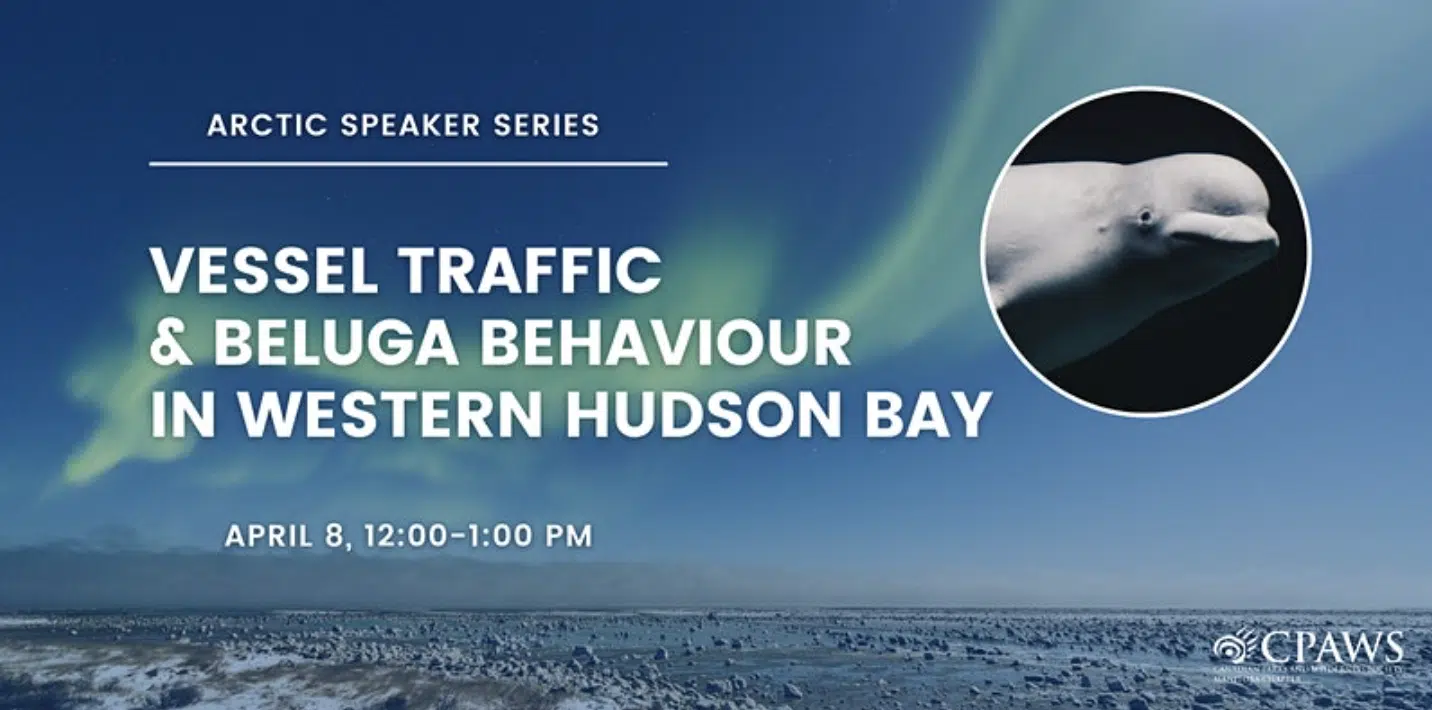
Vessel Traffic and Beluga Behaviour in Western Hudson Bay
Discover the work being done to study beluga whales in Manitoba from three University of Manitoba researchers.
Manitoba is home to one of the greatest concentrations of beluga whales on the planet.
As the ice melts in Western Hudson Bay, some 55,000 beluga whales migrate to the region’s major estuaries on the Churchill, Nelson and Seal rivers, to moult, calve, and feed.
But with longer ice-free periods in the Arctic sea, beluga whales could become more vulnerable to threats including increased vessel traffic, hydroelectric development, and predation from orca whales.
From 2019 to 2021, Veronica, Emma and Maddie — then all students at the Centre for Earth Observation of the University of Manitoba — travelled to Churchill, Manitoba to study the impacts of vessel traffic on beluga behaviour in the Churchill River estuary.
Join us for a CPAWS Manitoba webinar to learn what they discovered through their research, what it could mean for beluga whales in Manitoba, and the various methods they used to collect data including underwater microphones, computer vision technology, and time-lapse imagery.
The Churchill River estuary is an important habitat for the Western Hudson Bay beluga population and is a popular area for whale-watching tourism and a hub for northern shipping. Access is easy which provides incredible opportunities to see and learn more about these amazing whales.
Watch the webinar recording here.
This webinar is part of CPAWS Manitoba‘s Arctic Speaker Series, which explores the research being done in Manitoba’s Arctic and subarctic regions and highlights the global importance of the area. Manitoba’s north is a significant wildlife habitat, home to some of the largest concentrations of beluga whales and polar bears on the planet, along with hundreds of species of birds that nest along the coast of Western Hudson Bay. CPAWS Manitoba supports the safeguarding of these wild spaces and species through its Western Hudson Bay NMCA and Polar Bear Provincial Park initiatives.
About the Speakers
About Maddie:
Maddie is a research technician at the University of Saskatchewan, formerly a research associate at the Centre for Earth Observation at the University of Manitoba. She uses drones to collect remote sensing data of a wide range of landscapes, including LiDAR reconstructions of snowpack in the Rockies, multispectral measurements of soil moisture in the prairies, and videos of beluga whales in the Churchill River estuary. In collaboration with Wayne Chan at the U of M, she trained a computer vision algorithm to automatically detect and track surfaced belugas and tourist vessels in drone video of the Churchill River estuary.
About Emma:
Emma is pursuing a masters degree in Environment and Geography at the Centre for Earth Observation at the University of Manitoba. Her research involves the use of photogrammetry and geospatial analysis to investigate estuary habitat use of the Western Hudson Bay beluga population.
About Veronica:
Veronica is a PhD student at the Centre for Earth Observation of the University of Manitoba and Fisheries and Oceans Canada, with a project on underwater bioacoustics in Hudson Bay. Her background is in Physics and she has started specializing in underwater Acoustics during her Master’s, working in the Norwegian Arctic with the sea-ice team of the Alfred Wegener Institut. She is now studying marine mammal underwater vocalizations around Southampton Island and in the Churchill River estuary. She is interested in investigating how the marine fauna is going to react to the ongoing increase in vessel traffic in the Arctic which will unprecedentedly modify the underwater soundscape.
How can we help?
If you have any questions or require any additional accommodations to participate, please email us at [email protected].
About CPAWS Manitoba
CPAWS Manitoba has been instrumental in establishing 22 new parks and protected areas in our province. That’s an area larger than Lake Winnipeg at nearly 26,000 square kilometres. Our goal is to protect half of Manitoba’s lands and waters.
–Lunch and Learns–
Nature has been here for us during the pandemic.
CPAWS Manitoba wants to maintain this positive connection to nature by providing a space for Manitobans to connect online from the safety of our homes and be inspired by nature in our backyards and beyond.
Join CPAWS Manitoba for weekly lunch and learn presentations from experts across the province who will share their knowledge and passion and bring new nature-inspired activities into our lives.
*** This program is possible thanks to the generous support of The Winnipeg Foundation and the Conservation Trust, a Manitoba Climate and Green Plan Initiative delivered by the Manitoba Habitat Heritage Corporation. ***
